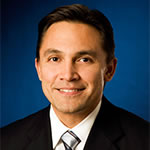
Ezra Garrett is the vice president of community relations and chief sustainability officer at PG&E.
Ezra Garrett helps 15 million Californians—or one in twenty Americans—operate their homes and businesses more sustainably. As vice president of community relations and chief sustainability officer at San Francisco-based Pacific Gas & Electric Company (PG&E), which strives to provide “safe, reliable, affordable, and clean energy” as well as development and community engagement, Garrett is at the forefront of his field.
PG&E strives to meet the so-called “triple bottom line”—the environmental, economic, and social outcomes of its work. “As a local utility company, we are in many ways an infrastructure company,” Garrett says, “so intuitively, we know that we have an economic impact, but we didn’t know precisely what that was. A commissioned study found that energy sales, investment in people, infrastructure, and suppliers supported nearly 72,000 jobs and contributed over $22 billion in economic activity in our service area in 2012. That surprised even us.”
Early in his career at PG&E, Garrett managed a portfolio of sustainability initiatives that included solar installations at local landmarks, including Grace Cathedral, the San Francisco Food Bank, and AT&T Park (the first Major League Baseball stadium to go solar), demonstrating that solar can add value without disrupting operations or aesthetics.
Today, Garrett and his team initiate community-based programs that engage and educate PG&E’s customers about the accessibility and affordability of renewable energy and efficiency. A partnership with Habitat for Humanity has resulted in the installation of solar on more than 500 Habitat-built homes. “That program saves $500 a year for those families,” he says. “When that’s aggregated and multiplied by the lifetime of these systems, those households will save over $7 million in energy costs.”

Garrett has helped guide sustainability initiatives such as solar installations at San Francisco’s AT&T Field and Grace Cathedral (below). Photo: GO Solar California

Grace Cathedral in San Francisco
Three key PG&E partnerships
Solar for Humanity
Working with Habitat for Humanity, PG&E has helped install solar panels on more than 500 Bay Area homes, saving more than $7 million in energy costs over the lifetime of the homes.
Future Workforce
Working with the California Department of Education, PG&E has created a three-year curriculum that prepares high school students for jobs in the energy industry.
Energy Education
Recently, PG&E has begun working with Net Impact, helping undergraduate and MBA students develop creative strategies for engaging consumers about energy use.
His department partners with others at PG&E to share the best sustainability practices from leading companies, explore key performance indicators, and then publicly report them in PG&E’s sustainability report. Identifying emerging issues and developing programs to address them requires leading an annual stakeholder engagement program with nonprofit Ceres; engaging environmental, customer-focused, investor, supplier, and community leaders in a conversation about PG&E’s progress; and soliciting input that helps shape the content of the sustainability report and the company’s broader strategy each year. Garrett’s team also recently completed PG&E’s first materiality assessment: an emerging practice that mapped the key priority issues for the long-term sustainability of the company, including what Garrett calls “a silver tsunami,” a euphemism for the company’s aging population.
“Over forty percent of our employees will be eligible to retire within the next five years,” Garrett says. “With the California Department of Education, we created partnerships in five high schools across PG&E’s service area. This three-year curriculum, a kind of ‘school within a school,’ will help create a workforce pipeline for our company.” The program is aligned with state educational standards, and students coming through the curriculum have demonstrated higher graduation rates, “and we are seeing them start to come into energy industry jobs as well,” Garrett says. This year, PG&E will offer summer internships to program participants.
Another recent partnership brought business school students from across the service area to PG&E to address customer engagement. Working with Net Impact, undergraduate and MBA students developed creative strategies to engage customers on energy use—a critical priority for PG&E and the state of California.
“PG&E delivers some of the nation’s cleanest energy and is pushing the frontiers of environmental innovation,” Garrett says. “But I wasn’t drawn to corporate sustainability because of that. For me, the real ‘ah-ha’ moment was coming out of the California energy crisis and seeing how a broader view of sustainability could enable programs and initiatives to have larger economic and social benefits just as powerful as the environmental ones. And when you bring all three together, there is a tremendous opportunity to create real value in the communities that we serve.”

